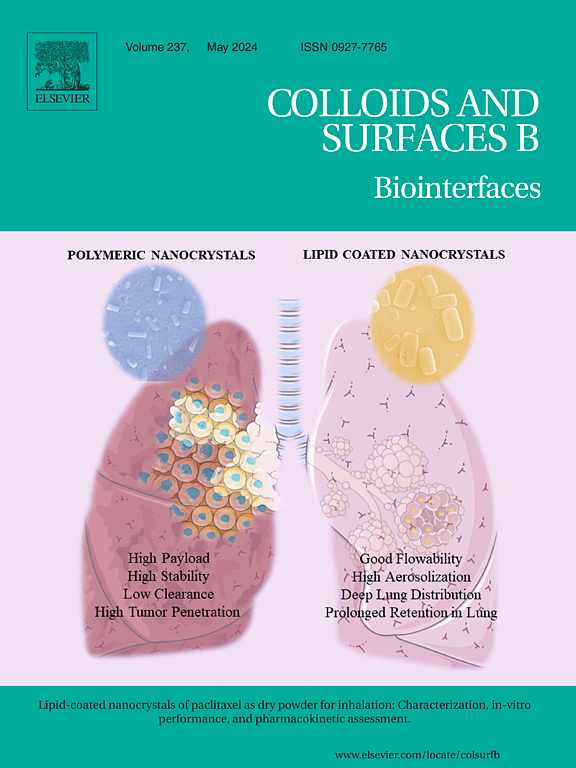Intranasal delivery of temozolomide and disulfiram in situ gel combined with copper for enhanced glioblastoma therapy
IF 5.6
2区 医学
Q1 BIOPHYSICS
引用次数: 0
Abstract
Combination therapies show promise for glioblastoma (GBM) treatment, however, insufficient drug accumulation in the brain and significant toxic side effects continue to pose critical challenges to therapeutic efficacy. Here, we report an intranasal ion-sensitive hydrogel (IHG) platform for efficient co-delivery of TMZ and disulfiram (DSF) to GBM via the nose-to-brain pathway. The optimized IHG formulation demonstrates superior gelation properties, sustained drug release, and enhanced brain accumulation, achieving remarkable drug targeting efficiency (468.9 %) and direct transport percentage (80.3 %). Within the tumor microenvironment, in situ-generated TMZ and the chelation product of DSF and copper ions (CuET) synergistically induce DNA damage and apoptosis, thereby enhancing tumor cell sensitivity to TMZ. Furthermore, tdIHG+Cu induces robust immunogenic cell death, stimulates CXCL10 release, mediates dendritic cell maturation, and promotes CD8+ T cell infiltration, thereby establishing a potent antitumor immune response. This approach not only demonstrates superior therapeutic efficy against GBM progression through enhanced intracranial drug accumulation and optimized drug ratios, but also minimizes systemic toxicity via localized delivery. Our findings offer a potentially clinical translatable strategy worth further investigation.
替莫唑胺和双硫仑原位凝胶与铜联合鼻内给药增强胶质母细胞瘤治疗
联合治疗显示出治疗胶质母细胞瘤(GBM)的希望,然而,药物在大脑中的积累不足和显著的毒副作用继续对治疗效果构成关键挑战。在这里,我们报告了一个鼻内离子敏感水凝胶(IHG)平台,用于通过鼻到脑途径将TMZ和双硫仑(DSF)有效地共同递送到GBM。优化后的IHG制剂具有良好的凝胶性、缓释性和脑蓄积性,具有显著的药物靶向效率(468.9 %)和直接转运率(80.3 %)。在肿瘤微环境内,原位生成的TMZ与DSF与铜离子的螯合产物(CuET)协同诱导DNA损伤和凋亡,从而增强肿瘤细胞对TMZ的敏感性。此外,tdIHG+Cu诱导强大的免疫原性细胞死亡,刺激CXCL10释放,介导树突状细胞成熟,促进CD8+ T细胞浸润,从而建立有效的抗肿瘤免疫应答。该方法不仅通过增强颅内药物积累和优化药物比例,对GBM进展显示出优越的治疗效果,而且通过局部给药,将全身毒性降到最低。我们的发现提供了一种潜在的临床可翻译策略,值得进一步研究。
本文章由计算机程序翻译,如有差异,请以英文原文为准。
求助全文
约1分钟内获得全文
求助全文
来源期刊

Colloids and Surfaces B: Biointerfaces
生物-材料科学:生物材料
CiteScore
11.10
自引率
3.40%
发文量
730
审稿时长
42 days
期刊介绍:
Colloids and Surfaces B: Biointerfaces is an international journal devoted to fundamental and applied research on colloid and interfacial phenomena in relation to systems of biological origin, having particular relevance to the medical, pharmaceutical, biotechnological, food and cosmetic fields.
Submissions that: (1) deal solely with biological phenomena and do not describe the physico-chemical or colloid-chemical background and/or mechanism of the phenomena, and (2) deal solely with colloid/interfacial phenomena and do not have appropriate biological content or relevance, are outside the scope of the journal and will not be considered for publication.
The journal publishes regular research papers, reviews, short communications and invited perspective articles, called BioInterface Perspectives. The BioInterface Perspective provide researchers the opportunity to review their own work, as well as provide insight into the work of others that inspired and influenced the author. Regular articles should have a maximum total length of 6,000 words. In addition, a (combined) maximum of 8 normal-sized figures and/or tables is allowed (so for instance 3 tables and 5 figures). For multiple-panel figures each set of two panels equates to one figure. Short communications should not exceed half of the above. It is required to give on the article cover page a short statistical summary of the article listing the total number of words and tables/figures.
 求助内容:
求助内容: 应助结果提醒方式:
应助结果提醒方式:


